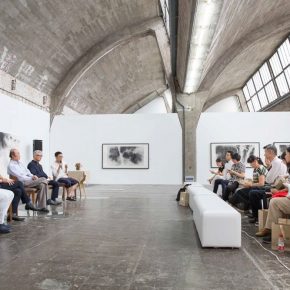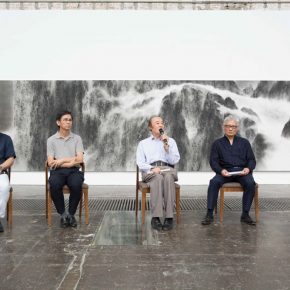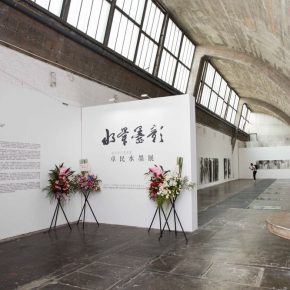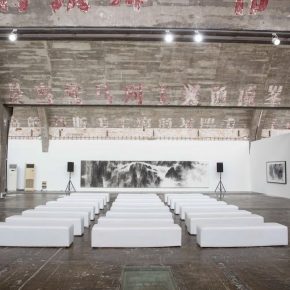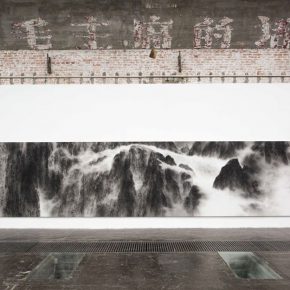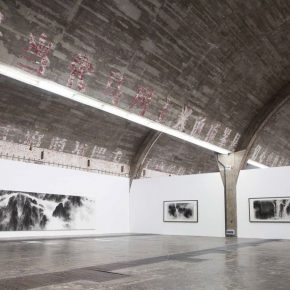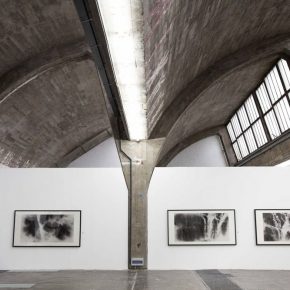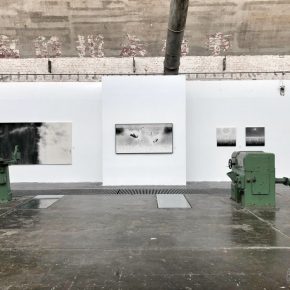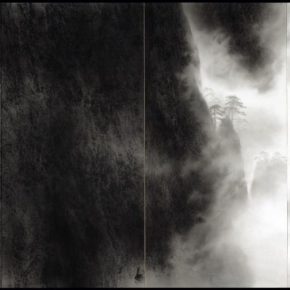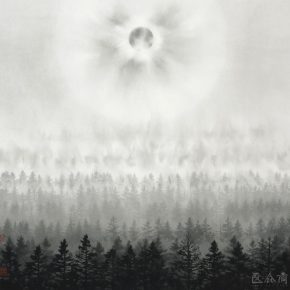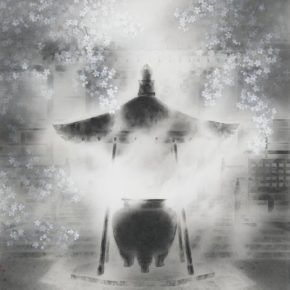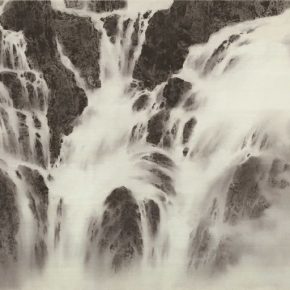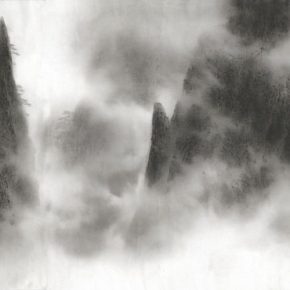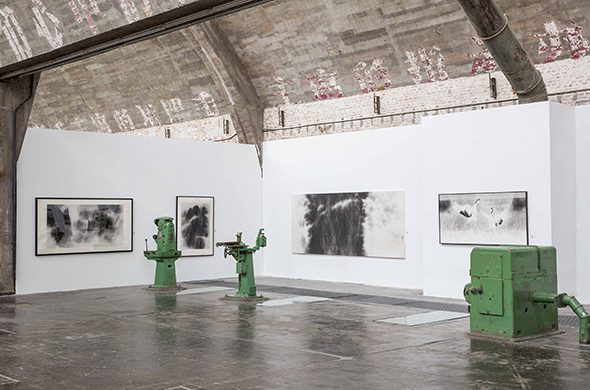
In the 1980s, many Western modern artistic ideological trends swarmed into China, so that artists were heavily influenced by those thoughts, and the practice of art tended to reveal diverse expressions. Artists began to explore the establishment of a visual cultural system with an independent discourse. This does not only require the artists to have made comprehensive theoretical research of the forms and styles of traditional ink and wash in different development periods over one thousand years and to have made creative experiments, but also proposes an urgent and realistic problem: in the era of globalization, Western discourse has been dominating the objective reality, how do we really understand the native ink forms and appropriately express it? Should we seek a balance between maintaining the intrinsic properties of the ink and wash forms and the diverse context of the global era?
For this reason, the “modern road of ink painting” has become a common reflection of contemporary artists and scholars. The artists who are good at thinking and exploring have made responses to this topic. They have practiced and made breakthroughs with their own artistic thoughts. The artist Zhuo Min is one of the practitioners.
On September 1, 2018, “The Old Words and New Tales – Zhuo Min’s Journey to Ink and Wash Exchange Meeting” was held at the 798 Art Factory. The exchange meeting was held at the hall featuring the ink and wash exhibition by Zhou Min, who is an artist residing in Japan and is a lecturer from the Tokyo University of the Arts. In addition to the artist, it also invited He Jiaying, Vice Chairman of the China Artists Association, the doctoral tutor of the Chinese National Academy of Arts, and the honorary president of the China Academy of Gongbi Painting, Wang Yong, a researcher and a doctoral tutor of Chinese National Academy of Arts, Hang Chunxiao, a researcher and a doctoral tutor of Chinese National Academy of Arts and the curator of the exhibition, and Wang Yanling, Chairman of the Beijing 798 Cultural and Creative Industry Investment Co., Ltd., to attend the meeting and to exchange their ideas. It tried to start from the creative practice of Zhuo Min’s ink and wash to explore a new way of modernization of Chinese ink and wash.
Keep a Distance from the Ink and Wash Constructed by the Literati
The “Chinese traditional ink and wash” that we discussed at the moment was rooted in the ink and wash context constructed by the literati since the Yuan Dynasty, while the ink and wash of the Five Dynasties and Northern Song Dynasty did not receive much attention. “Currently, the majority of the freehand brushwork forms are created on raw rice paper, and it is a suspicion of partiality and blindness, which has hindered the diversified development of Chinese ink and wash.” Zhuo Min, who has taught in Japan for many years, is called “a scholar-type painter” by the curator Hang Chunxiao. His ink and wash works are quite different from the ordinary ink-and-wash works because they achieve the “implantation of a certain problem consciousness.”
Hang Chunxiao pointed out that in the literati painting system since the Yuan Dynasty, “making” was shaped as the opposite of “writing” and was reprimanded by people. In such a discourse system, it is easy for people to form the cognitive inertia of “believing writing” and “ignoring making”. Many painters who are engaged in the creation of Gongbi paintings constantly emphasize that they have the quality of “writing”, which is the unconscious reaction under this cognitive inertia. Therefore, the concept of “making” and the judgment of paintings which was formed around this concept have become the “cage” for the current creation of ink and wash – which shows that we have potentially used the literati ink-and-wash paradigm established since the Yuan Dynasty as the premise of all things. However, the paintings which were created after the Yuan Dynasty were quite different from those created before the Song Dynasty and the ones created in the Song Dynasty. Seen from this point of significance, an “approximate tradition” has obscured the path leading to a long historical tradition.
Zhuo Min’s ink and wash paintings attempt to establish a dialogue with “historical cognition” through a reflection on the confirmed cognition of “writing which is placed in the first place and making is ignored”. In his view, compared to the spiritual pursuit of literati painting, the ink and wash paintings of the Song Dynasty have continued with a variety of painting elements including the shape, color and space of mural paintings, so that it is the classical canon of Chinese paintings. The ink and wash paintings should return to the visual form and the original source of painting, and it is the foundation and the way for ink and wash to move towards modernization.
Take the Hemp Papers Widely Used in the Tang and Song Dynasties as Support
The hemp papers offer longer and stronger fibers, and can be repeatedly painted and scrubbed by different media (rock color, ink and wash). It is an important support for the Chinese rock color painting which is still growing in China; it is also an important support to break through existing formal programs and to develop the styles of Chinese paintings for the light ink and wash color or the paintings with exact delineation and enriched colors.
Zhuo Min believed that supports and medium were the most important material carriers for painting art, and the supports restrict and affect the language form of paintings, while the different regions, different plant characteristics, different additional materials, and the different quality of papers were the important reasons why the ink and wash is presented with a great variety of shapes and forms, why it is everlasting. Zhuo Min used clam meals to create on the hemp paper and finished a series of paintings of peony flowers. The grainy clam meals were thrust aside by water and evenly covered the paper, which created a translucent visual effect, and it is one example of the fusion of the support and medium. “Chinese painting is equivalent to ink and wash, and raw rice paper and ink, which is a conceptual model gradually formed over the past two hundred years that is increasingly affecting our entire and comprehensive grasp of Chinese painting, and it even influences the public opinion orientation of Chinese painting criticism. It is possible to make Chinese ink and wash become trapped in a language program getting narrower and narrower,” Zhuo Min expressed his doubt about this status quo and questioned what “is this situation supposed to change?”
Zhuo Min chose hemp papers which were undoubtedly related to Zhuo Min’s experience of residing in Japan. Wang Yong believed that Zhuo Min’s use of hemp paper as support, which has continued the lost chapter of Chinese history of art and the Sino-Japanese art exchange. Zhuo Min, who has studied and worked in Japan for more than 30 years, his creations are derived from a care of nature, derived from the understanding of the traditional realm, derived from the spirit of the paintings of the Song and Yuan Dynasties, and also the inspiration from the traditions inherited by Japan.
What Are the Different Results Brought by the Ink and Wash from an Overseas Perspective?
In addition to the application of material media, seeing the works by Zhuo Min, snow trees, silver flowers, falling petals, distant mountains, the clear moon …, from the aesthetic level, we can see a quiet and secluded quality in Japanese culture, which is similar to the philosophical feeling of the harmony of the scenery depicted and the emotions expressed. Because Zhuo Min has resided in Japan for decades, and this identity offers him an overseas perspective, and gives us inspiration for the development of ink and wash from a different perspective.
“Why can’t the ink and wash become the culture commonly enjoyed by human civilization? Have we created many obstacles for ourselves and have we prevented it from going abroad? In the current era of pluralism, how does oriental art affect the world?” Regarding this question, He Jiaying believed that excessive emphasizing the form of “brush and ink” was one of the reasons why ink and wash could not form the common language of painting in the world as oil painting did. “If Chinese ink and wash tries to be shared by people, it should first weaken the use of brush, so any tool is accessible. We should emphasize the ink and the media itself.”
In the era of globalization, the development of the Internet and various technological means has fully broadened the scope of geographical theory. In this context, it determines that we should look at the development of ink and wash art from a broader cultural perspective. Is there any assumption of “China living alone in the world”? At the end of the exchange meeting, Hang Chunxiao said: “Rather than a discussion of returning to the so-call China, we should replace this problem and return to the reality – whether it is history or the West, it is the ‘other’ for us, and we are just pretending about these two ‘others’ to shape the ‘self’, and returning to the ‘self’ to find problems, which is the fundamental way to solve the current problems.”
Text by Lin Jiabin, translated by Chen Peihua and edited by Sue/CAFA ART INFO
Photo courtesy of the organizer



